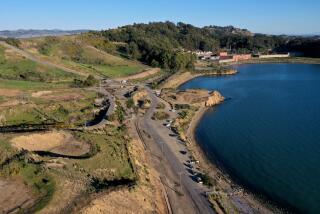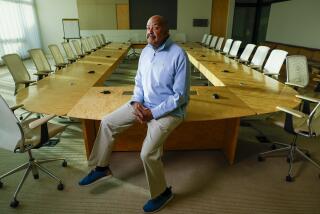RAND Seeks to Be the Thoughtful Think Tank : Research: Company tries to polish its image. A long-stalled expansion plan may hinge on the effort’s success.
- Share via
When she was offered a job at the RAND Corp., economist Julia Lowell made one thing clear: “No bombs or bullets” research for her.
In associating the international think tank with military hardware, Lowell had fallen prey to a common stereotype, one she soon found was inaccurate.
“My perception of what RAND does, even in security areas, was incorrect,” said Lowell, 32, whose research concerns international monetary policy. “They study really important national security things . . . like arms control.”
In other words, there are no bombs in the RAND Corp. basement, as some folks still believe. Nor is the place swarming with mad scientists hellbent on blowing the world to smithereens. Although the Defense Department is still its biggest client, the Santa Monica-based think tank is as likely to be studying child care in the military as plotting missile sites.
In recent years, RAND has begun trying to improve its public image, which was tinged by the company’s involvement in landmark Cold War defense decisions and as a site for protests against the Vietnam War.
That effort is particularly important now: RAND needs the goodwill of the Santa Monica community to implement long-stalled plans to expand its headquarters, located between City Hall and the beach. The project would allow the think tank to put all its workers under one roof and add more conference space.
To pay for the expansion and create an endowment that would make it less dependent on government and foundation funding, RAND is also seeking to develop its nearly block-long stretch of investment property on Ocean Avenue, just south of its offices.
After several years of study, the expansion was approved unanimously by the Santa Monica City Council in November as part of an overall plan to revamp the Civic Center area. But a referendum on the proposal appears to have gathered enough signatures to qualify for the ballot, so voters will probably get the final say.
That leaves RAND in the position of selling itself to a city that has been its home for more than 40 years.
*
The groundwork for the sales pitch is already in place. After decades of aloofness in the face of criticism of its defense work, RAND has been busy mending fences with residents of one of the nation’s most liberal cities. The think tank has scored points by doing good works ranging from leading a holiday charity drive to giving the city technical advice.
The reception, however, has not been uniformly warm.
Despite the end of the Cold War, opposition to the headquarters expansion project is tinged with anti-RAND sentiment. Some Santa Monicans, including Democratic state Sen. Tom Hayden, are not willing to let bygones be bygones.
To them, it seems, RAND is forever epitomized by a thinly disguised reference to the think tank in the 1964 black comedy film “Dr. Strangelove,” in which the BLAND Corp. coldly performs a cost-benefit analysis for a “doomsday device.”
“We can’t get away from the vision of Dr. Strangelove,” RAND computer scientist David McArthur said. “I love the movie, but it’s not RAND.”
*
What is RAND then? It’s somewhat akin to a university without students, populated by highly educated, intellectually curious sorts who become so engrossed in their work that the company pays them a bonus for using their vacation days. Called researchers or policy analysts, they grapple with the problems of today and look to the future.
This year, the think tank was involved in one of the country’s hottest issues--gays in the military. Plucking staff analysts from several departments to study the matter from all angles, RAND concluded that sexual orientation is not germane to military service, advice the Pentagon and President Clinton did not heed. (Instead, the Pentagon and the President agreed to a compromise that continues to place restrictions on gay soldiers.)
RAND’s health care experts, meanwhile, quietly advised Hillary Rodham Clinton’s task force this year on health care reform. And other researchers made headlines with a controversial, explicitly worded sex survey of Santa Monica High School students.
On the aerospace front, a study released in December recommended against building more Milstar communications satellites, at a cost of $1 billion apiece, to help wage nuclear war. No need, RAND said.
Security is evident at the think tank’s offices. Visitors must present identification and are not allowed to stroll the corridors without an escort.
In one building, nondescript offices flank long, dark hallways that appear uninviting, but were designed by a mathematician to maximize encounters between researchers.
“A lot of intellectual work we do here is stimulated by casual interaction,” said Iao Katagiri, the think tank’s community relations director.
Dress tends more toward Levi’s than tweeds or pearls. And on a recent workday there was nary a pocket protector in sight, although RAND President James A. Thomson admitted a careful search of the premises would surely find a few.
*
Whether they study Japanese currency, transportation systems or gender bias in the courts, all of the dozen RAND employees interviewed for this story gave similar descriptions of their workplace. It is, they say, a casual, non-hierarchical, even nurturing place that honors creativity.
The researchers said they prefer RAND to academia because of the think tank’s trademark interdisciplinary approach and their preference for working to resolve real-life problems.
“The interchange of ideas . . . is much more intellectually exciting and challenging than research done in academic institutions,” said Elizabeth A. McGlynn, a health policy analyst with “Sylvia” cartoons taped to her door.
Who pays for all this thinking? Essentially, we do. Currently, 65% of RAND research is defense-related and paid for by the government, which funds some domestic research as well. RAND is in the middle of a five-year plan to equalize the ratio of defense to civilian work, “domesticating” some of its defense specialists and offering early retirement to others.
This is essentially a best-of-times, worst-of-times period for think tanks. The post-Cold War era offers lots of new problems to analyze, but there is less public funding available to pay for it.
Accordingly, RAND is trying to broaden its funding base, going beyond government and foundation grants to reach out to private industry and individual donors, without sacrificing its independence.
RAND--an acronym for research and development--evolved from Project RAND, a research group formed at the close of World War II. The idea was to continue the relationship between scientists and the military that bloomed during the war.
RAND incorporated in 1948 and bought the land for its offices from the city in 1952 for $250,000. RAND acquired most of the property on its block as it became available, boarding up the dilapidated buildings in anticipation of turning them into a mix of office space and housing.
Although RAND officials say they cannot put a price tag on the think tank’s 15 acres of seaside property because the property’s zoning status is in limbo, estimates of its worth have varied over the years from $65 million to twice that much.
*
The RAND location, although idyllic, became a popular site not only for anti-war demonstrations over the years, but also for protests against nuclear testing and research. As recently as the Gulf War, the think tank drew protesters.
In 1984, RAND was in the limelight when peace activists tried to make Santa Monica a “nuclear-free zone,” a proposal that, if passed by voters, would have prevented RAND from even researching nuclear subjects. It lost by a 2-1 margin.
But the worst brouhaha involving RAND was the publication of the Pentagon Papers, which exposed lies the government told the public about the Vietnam War. The secret documents were stolen from the RAND building by their author, Daniel Ellsberg, and leaked to the New York Times, resulting in the loss of the think tank’s security clearance for a time and highlighting its classified military research.
No wonder RAND kept a low profile in the community for years.
Now, however, RAND is broadcasting its community involvement. Employees are involved in about 70 local organizations, led by Vice President Rae W. Archibald, chairman of the board of the city’s largest homeless service agency, the Ocean Park Community Center.
Apart from its economic worth as the city’s third-largest employer (1,100 employees and a $65-million annual payroll), RAND is an asset to a “cutting edge” place like Santa Monica, City Manager John Jalili said.
Jalili said he just picks up the phone to pick some of the best brains in America, experts who have helped Santa Monica set up its public computer network and counseled the city on its programs for seniors, youth and the homeless.
As part of its fence-mending effort, RAND has for the last two years been the lead organizer of Share the Holidays, a multi-agency drive to gather food, clothing and toys for needy people.
Such efforts have not moved Hayden, a leading opponent of the Civic Center plan, who has said that an agency with RAND’s history does not belong in a Civic Center at all. Initially, he tried to persuade RAND to swap its land. And he is definitely not of a mind to accommodate the think tank’s quest for financial security.
In written testimony to the City Council recently, Hayden said the city should insist on knowing whether RAND is conducting research on “nuclear, chemical or bacterial weapons.” Only then can the city “make an informed decision about whether to allow such a private developer to cast the tallest shadow over the symbolic center of our civic life, the public square,” Hayden said.
At present, RAND is not playing its trump card by threatening to sell its property and move. “We’ve had to listen to a lot of malarkey about this institution . . . (but) we like it here,” Thomson said. “We’ve been here forever.”
More to Read
Inside the business of entertainment
The Wide Shot brings you news, analysis and insights on everything from streaming wars to production — and what it all means for the future.
You may occasionally receive promotional content from the Los Angeles Times.










